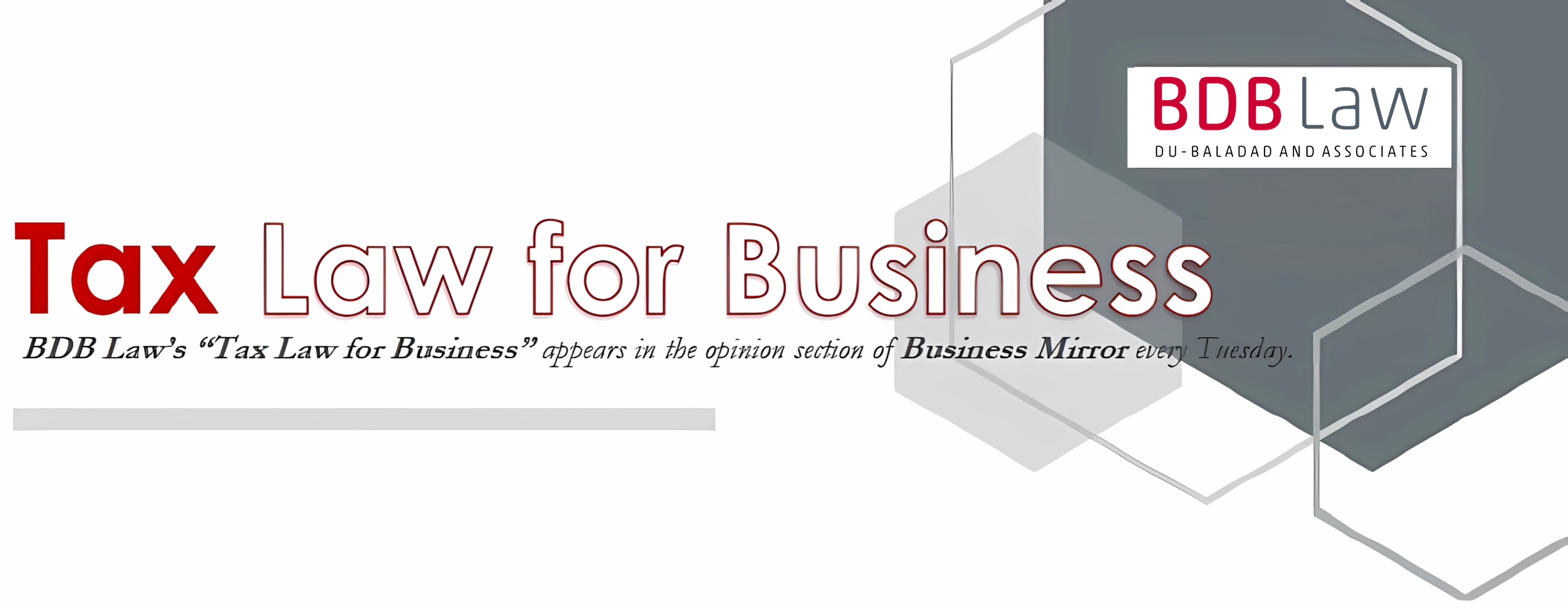
The Electronic Push for Invoicing and Sales Reporting
By: Atty. Jomel N. Manaig
"The implementation of electronic invoicing and electronic sales reporting has been on the uptick in other countries. The benefits and advantages of digitalization and electronic adoption are undeniable. It promotes cost-savings, streamline operations, promotes scalable volume, and leverages on other emerging technologies (such as artificial intelligence and automation), just to name a few."
 Atty. Jomel N. Manaig +632 8403-2001 loc. 140 |
The implementation of electronic invoicing and electronic sales reporting has been on the uptick in other countries. The benefits and advantages of digitalization and electronic adoption are undeniable. It promotes cost savings, streamlines operations, promotes scalable volume, and leverages on other emerging technologies (such as artificial intelligence and automation), just to name a few.
It is no surprise that the Philippines has been trying to jump on the wagon as well. To enable this, the BIR issued Revenue Regulations No. 11-2025 (RR 11-2025), which implements the Electronic Invoicing System (EIS) and the Electronic Sales Reporting System (ESRS). While RR 11-2025 is a fresh revenue issuance, it should be noted that the EIS and ESRS are not new concepts.
 As early as 2017, TRAIN Law introduced EIS and ESRS and mandated the shift from the old but reliable paper-based invoices to the future-looking electronic invoices. The shift was supposed to take effect within 5 years from the effectivity of the TRAIN Law and upon the establishment of a system capable of storing and processing the required data. A pilot implementation was then performed on July 1, 2022, covering 100 large taxpayers.
As early as 2017, TRAIN Law introduced EIS and ESRS and mandated the shift from the old but reliable paper-based invoices to the future-looking electronic invoices. The shift was supposed to take effect within 5 years from the effectivity of the TRAIN Law and upon the establishment of a system capable of storing and processing the required data. A pilot implementation was then performed on July 1, 2022, covering 100 large taxpayers.
But, alas, despite the best of intentions, the EIS and ESRS stumbled upon roadblock after roadblock until nothing was ever heard of the electronic push again. And before the electronic systems faded into the collective short-term memory of taxpayers, it created a flurry of concerns from those covered by it.
When the BIR appeared to be moving forward with the EIS and ESRS, it provided for general policies and guidelines (under RR 08-2022) for covered taxpayers to follow. It also said that a separate issuance shall be provided for the details and specific requirements. But those details never came.
Creating, or even purchasing, a system that can electronically issue invoices and electronically transmit data and information to the BIR is not a simple feat. For those that have customized systems, they would need to know the technical requirements to connect with the system of the BIR itself. For those that will purchase, costs and budgets are a perennial issue. And so, with the implementation of the EIS and ESRS seemingly drawing close, a lot of covered taxpayers lacked the necessary information and guidance to be able to plan their compliance options.
At this point, eight years have passed from the time the EIS and ESRS were first introduced, and the BIR issued RR 11-2025 to implement it once more. But how does RR 11-2025 differ from RR 8-2022?
CLEARER DEFINITIONS. Unlike RR 8-2022, the new regulations laid down basic definitions on key and fundamental concepts to implement EIS and ESRS. These definitions are comprehensive and technical enough to avoid confusion and ambiguity in understanding the terms.
However, the technical nature of the definitions also brought in a possible problem: a layperson’s difficulty in understanding. Technical definitions are welcomed by technical people. However, laypersons may have a hard time understanding some technology-related terminologies and concepts. Hopefully, a revenue memorandum circular can address this.
ADDITIONAL MANDATORY COVERED TAXPAYERS. RR 8-2022 only mandated three groups of taxpayers to adopt the EIS and ESRS: (i) exporters; (ii) taxpayers engaged in e-commerce; and (iii) taxpayers in the Large Taxpayers Service. The covered taxpayers, however, have now increased to include large taxpayers, those using computerized accounting software/computerized books of accounts with accounting records/point-of-sale systems, and registered business entities availing of tax incentives.
In certain instances, the inclusion in the coverage would depend on the BIR’s establishment of a system capable of storing and processing the required data. This phrase sounds familiar, right?
Going back to the pilot implementation, the BIR already encountered issues with just 100 large taxpayers. With the increased coverage, will history repeat itself? I hope and pray that it won’t. Optimistically, I would actually like to think of it as the BIR just paving the way for future implementation when it is ready, as opposed to sowing concerns and confusion for an implementation that is nowhere in sight.
IMPLEMENTATION PERIOD. The implementation of the EIS under RR 11-2025 shall be within 1 year from the latter’s effectivity. On the other hand, electronic transmission shall be implemented upon establishment of a system capable of storing and processing the required data.
Only time will tell whether this period is achievable. While the timeline of the previous attempt to implement the EIS and ESRS does not inspire confidence, we hope that the learnings from then would provide a solid foundation now. Perhaps, one thing I would like to request this time around is for the BIR to give regular updates and developments. Any news, including any delay or revised timeline, would be a better alternative than just letting taxpayers fumble around in the dark.
The author is a partner of Du-Baladad and Associates Law Offices (BDB Law).
The article is for general information only and is not intended, nor should be construed as a substitute for tax, legal or financial advice on any specific matter. Applicability of this article to any actual or particular tax or legal issue should be supported therefore by a professional study or advice. If you have any comments or questions concerning the article, you may e-mail the author at This email address is being protected from spambots. You need JavaScript enabled to view it. or call 8403-2001 local 140.



